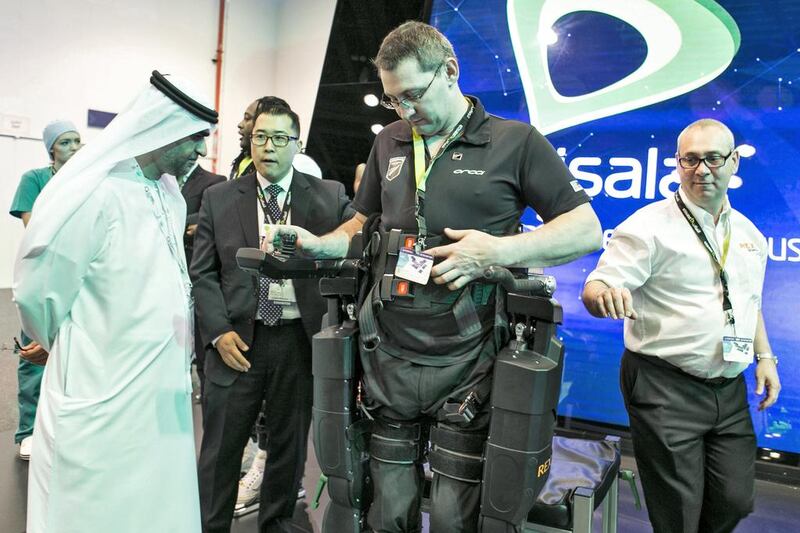DUBAI // Robotic technology combined with the human form has long been the stuff of science fiction, but big advancements in the field are now helping paralysed patients to walk.
Amana Healthcare could be the first in the UAE to use a robotic exoskeleton, or Rex, to get disabled people out of their wheelchairs and walking around, at its centres in Al Ain and Abu Dhabi.
The technology was on show at Gitex, an annual international IT exhibition, in Dubai.
Ten motors replicate joints in a carbon-fibre shell, operated by joystick, or the thoughts of those paralysed from the neck down via a skullcap. The Rex walker also has the benefit of reducing muscle wastage in patients by exercising unused limbs.
› Check out the Rex walker in action here: Visitors try out Robot Walker at Gitex 2015 - video
At US$160,000 (Dh587,780), the tech is not cheap but discussions are under way for Amana to offer the robotic rehabilitation suit under health insurance at its Abu Dhabi recovery centre.
New Zealander Lee Warn, 39, was paralysed from the waist down in a motorcycle accident and assisted in the product’s development by engineers near his Auckland home.
“My T12 (thoracic vertebra) was smashed and I broke two ribs that punctured my lungs when I hit a kerb on a small motorcycle,” he said. “I was 16. I remember doctors and my parents at my bedside telling me I would spend the rest of my life in a wheelchair.”
As part of his physiotherapy, Mr Warn would spend half an hour a day in a standing frame to strengthen the muscles he had stopped using.
“When I heard about the Rex project, it intrigued me,” he said. “I had a massive smile on my face the first time I used it, it was so cool.
“I had not taken any steps in 14 years. I had forgotten how tall I was.”
The device could also help in reducing injuries induced by the manual handling of patients by healthcare staff.
It usually takes about five care staff to work with a patient during physio sessions. The Rex walker allows one-to-one care, freeing up a physiotherapist to work with up to eight patients a day. It can also help stroke patients to recover.
Tom Priestley is a British physiotherapist who runs the clinical side of Rex Bionics.
“There is no limit to how this can be used,” he said. “I have worked with someone who had no movement from the neck down but could control the Rex with their thoughts.
“It works out what wave frequency your motor cortex is giving off and responds.”
Early prototypes weighed about 85 kilograms and were built around an aluminium frame. Using the same carbon fibre as boats in the America’s Cup, the weight has been reduced by 30kg. A more advanced model, called Rex P, can walk up stairs and take on 30-degree gradients.
It moves at a third of normal walking pace, with two hours of battery life and one required hour to do a recharge.
Ali Hashemi, director of Amana Healthcare in the UAE, said: “This technology is not yet available in the UAE but we are discussing being the first provider to bring it here.
“Rex is relevant to what we do for people who have been in car accidents, or may never walk again.”
Bringing Rex to the UAE will depend on the regulatory framework and its approval by the Ministry of Health.
“Its cost would need to either fit into the insurance framework, or the Government’s healthcare cost for nationals,” Mr Hashemi said.
Amal Alhajeri, 36, a senior Etisalat information security manager in Abu Dhabi, is paraplegic from a car crash. She said: “I like the concept but it would be even better if it was lighter and smaller. Sitting in a wheelchair for a long time, you lose strength and flexibility. This machine would help improve that. This is expensive but it is a good idea.”
nwebster@thenational.ae







